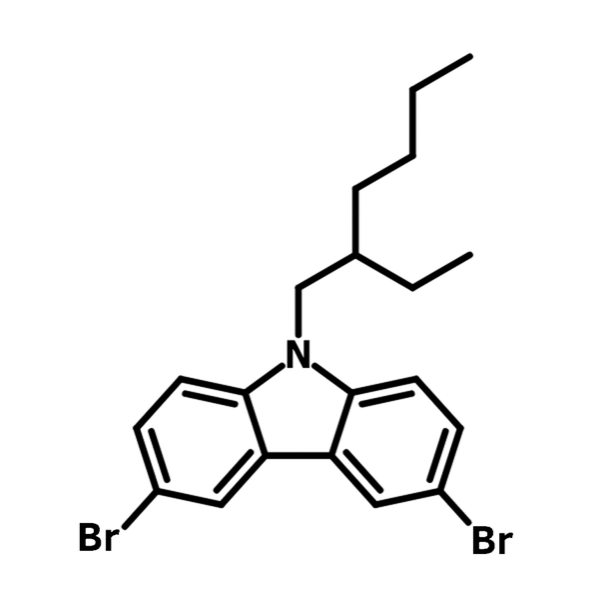3,6-Dibromo-9-(2-ethylhexyl)-9H-carbazole
CAS Number 173063-52-0
Chemistry Building Blocks, Dibromo Monomers, Materials, MonomersA dibromo-substituted 2-ethylhexyl-carbazole building block
serves as a monomer in the preparation of organic semiconducting materials for use in solar cells and OLEDs
Specifications | MSDS | Literature and Reviews
3,6-Dibromo-9-(2-ethylhexyl)-9H-carbazole (CAS number 173063-52-0) is a carbazole derivative bearing two bromide groups at 3 and 6-positions as well as a 2-ethylhexyl group at the 9-position. The bromo-substituents enable 3,6-dbromo-9-(2-ethylhexyl)-9H-carbazole to undergo facile reactions, including Suzuki coupling reactions and Kumada polymerisation. A carbazole copolymer, linked at the position 2,7 and 3,6, is synthesised by combining 3,6-dibromo-9-(2-ethylhexyl)-9H-carbazole with 2,7-dipinacol-(2-ethylhexyl)-9H-carbazole. The resulting carbazole copolymer possesses a wide band gap of 3.2 eV and displays a narrow emission band at 400 nm (with a full width half maximum of 56 nm).
Low Cost
Competitive pricing
Worldwide shipping
Quick and reliable shipping
Versatile building block
works in different reactions
Synthetic monomer
Synthetic monomer for HTL materials (in OPVs and OLEDs)
A novel copolymer of fluorene and carbazole, known as PF8Cz (poly[(9,9-dioctylfluorenyl-2,7-diyl)-alt-(9-(2-ethylhexyl)-carbazole-3,6-diyl)]) can be prepared from 3,6-dibromo-9-(2-ethylhexyl)-9H-carbazole and 2,2'-(9,9-dioctyl-9H-fluorene-2,7-diyl)bis(4,4,5,5-tetramethyl-1,3,2-dioxaborolane). PF8Cz has an optical bandgap of 3.06 eV, widely used as a hole-transport layer (HTL) material in OLEDs.
General Information
| CAS Number | 173063-52-0 |
| Chemical Formula | C20H23Br2N |
| Full Name | 3,6-Dibromo-9-(2-ethylhexyl)-9H-carbazole |
| Molecular Weight | 437.22 g/mol |
| Synonyms | 3,6-Dibromo-N-(2-ethylhexyl)carbazole, 9-(2’-Ethylhexyl)-3,6-dibromo carbazole |
| Classification / Family | Carbazole building blocks, Bromide ligands, Organic photovoltaics, Polymer solar cells, Perovskite solar cells, Polycarbazoles, OLEDs, Hole-transport layers, Organic semiconducting materials |
Chemical Structure

Product Details
| Purity | 98% |
| Melting Point | N/A |
| Appearance | Colourless to pale yellow liquid |
MSDS Documentation
 3,6-Dibromo-9-(2-ethylhexyl)-9H-carbazole MSDS Sheet
3,6-Dibromo-9-(2-ethylhexyl)-9H-carbazole MSDS Sheet
Literature and Reviews
- Alternating 2,7- and 3,6-linked carbazole copolymers as wide band gap energy transfer donors, D. Pickup et al., The Solid Films, 517(9), 2840–2844(2009); DOI: 10.1016/j.tsf.2008.10.044.
- Carbazole-functionalized polyfluorenes: synthesis and conformational properties in chloroform solution and β-phase formation in copolyfluorene films, M. Simonova et al., Mater. Today Chem., 22, 100553(2021); DOI: 10.1016/j.mtchem.2021.100553.
- Efficient synthesis of well-defined polycarbazoles via catalyst-transfer Kumada coupling polymerization, H. Wen et al., Eur. Polym. J., 49(11), 3740–3743(2013); DOI: 10.1016/j.eurpolymj.2013.08.016.
